
|
![]()
Greatest Films of the 1940s
1940 | 1941 | 1942 | 1943 | 1944 | 1945 | 1946 | 1947 | 1948 | 1949
Title Screen Film Genre(s), Title, Year, (Country), Length, Director, Description 

Ball of Fire (1941), 111 minutes, D: Howard Hawks
This classic Howard Hawks film was often considered an adult version of the legendary Snow White and the Seven Dwarfs tale - and was one of the last "Golden Age" screwball comedies. Scriptwriters Billy Wilder and Charles Brackett adapted co-author Wilder's own story "From A to Z" for the Samuel Goldwyn-produced and RKO-distributed film. In the plot, a group of eight, white-haired, conservative-minded, elderly bachelor professors ("squirrelly cherubs") had been living and working together in the same Manhattan home for nine years - engaged in a 12-year effort to write-compile an encyclopedia or dictionary. Professor Bertram Potts (Gary Cooper), a naive, innocent, pedantic, and square linguist (or grammarian) and the youngest of the men, led the group. Each scholar was a specialist in a particular discipline, subject or study area, and was assigned to write articles based upon their research. Their project was financed by rich investor Miss Totten (Mary Field) and the Daniel S. Totten Foundation, who was now insisting that the men finish their leisurely-paced work as soon as possible. As the professors mostly worked in seclusion in the orderly inner environment of the house, tended by housekeeper Miss Bragg (Kathleen Howard), they were very sheltered and unfamiliar with the outside world. During Potts' research into the subject of "Slang," he realized that the article he was working on was completely out-dated and needed revision. This required him to leave the house - he would be the only one to do so in nine years. In a nightclub, he listened to the singing performance of worldly, sexy, smart-mouthed and flirtatious singer-dancer Katherine "Sugarpuss" O'Shea (Barbara Stanwyck), a gangster's moll. Although she initially rejected his invitation to help in his linguistic research into slang (by visiting with him in the scholars' house), she was forced to agree when she found herself on the run from the law, and needed a place to hide. Sugarpuss had become a witness to a murder committed by her mob boss boyfriend Joe Lilac (Dana Andrews). The presence of the vivacious and seductive Sugarpuss in the house completely disrupted progress on the encyclopedia, especially when she instructed the men to dance with her in a Conga line. Although she could help with the slang research, Potts asked her to leave since her sexiness threatened his work. She claimed she was in love with him: "I couldn't stop thinking about you after you left my dressing room," and she called him "big and cute and pretty...to me, you're a regular yum-yum type." Also admitting she was "just plain wacky" over him, she proposed to show priggish Potts the meaning of "yum-yum." First, she had to elevate her height by standing on two reference books: "I'm gonna show you what yum-yum is. Here's yum." She kissed him with her arms around his neck. Then, she said: "And here's the other yum" (a second kiss), followed by: "And here's yum-yum." The force of the third kiss caused them to topple backwards onto the floor. Inevitably, Potts fell in love with Sugarpuss and proposed marriage, while at the same time, Joe Lilac also schemed to marry her to keep her from testifying against him. In the film's zany conclusion, the scholars cleverly and heroically out-witted the gangsters sent to prevent them from interfering in Lilac's forced marriage to Sugarpuss. She was rescued and the gang of gangsters was captured, and Potts proved himself to her by knocking out Lilac and forcefully giving her a passionate "yum-yum" kiss while providing her with three books to stand on: ("Gentlemen, as a grammarian, I know when words cease to be of use. There remains one argument. Come here, dear...Get up, darling....").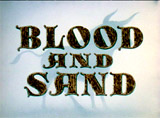


Blood and Sand (1941), 125 minutes, D: Rouben Mamoulian
Director Rouben Mamoulian's and 20th Century Fox's Technicolored romance melodrama was adapted by Jo Swerling and based upon Vincente Blasco Ibanez's 1908 novel Sangre y Arena. An earlier version of the novel was portrayed in the silent film Blood and Sand (1922) starring Rudolph Valentino. The 1941 drama was intended as a follow-up film to the previous hit film The Mark of Zorro (1940) a year earlier, with the same major stars (it was the 4th and final film pairing Tyrone Power with Linda Darnell). The film had two Academy Awards nominations and won one Oscar (Best Cinematography). The storyline followed the rise and fall of an illiterate peasant from the town of Seville named Juan Gallardo (Rex Downing as child, Tyrone Power as adult) who followed in his deceased father's footsteps to become an acclaimed Madrid bullfighter. After achieving fame and wealth in the bullring about a decade later, he returned to his village to marry his aristocratic child sweetheart Carmen Espinosa (Ann E. Todd as child, Linda Darnell as adult). As Spain's greatest matador, he caught the eye of beautiful, sultry temptress and socialite Dona Sol des Muire (Rita Hayworth in a breakthrough role). His self-destructive, egotistical downfall came during their affair when he neglected his pious, long-suffering and faithful wife Carmen (and she left him), and his decadent lifestyle also affected his training and skills as a bullfighter. Rejected by his followers (and even Dona Sol), when he tried to regain his fallen fame and popularity in the bullring with one climactic fight, he was tragically gored by the bull and died in Carmen's arms. In the background, cheers erupted for up-and-coming brutish matador Manolo de Palma (Anthony Quinn), Juan's childhood friend and Dona Sol's new paramour, who was victorious over the bull. In response to the crowd that had already forgotten Juan, Manolo expressed his gratitude by bowing near the stain left in the sand by Juan's blood.


Citizen Kane (1941), 119 minutes, D: Orson Welles
This was Orson Welles' unqualified masterpiece - a major movie milestone in cinematic history. It has often been considered by most film critics as the greatest of all-time, or one of the top ten films ever made. It rewrote the rules of Hollywood cinema, setting Hollywood on its ear when first released. The film was co-written, directed, and starred in by 25-year old radio star Orson Welles in his first film effort and on a bare-bones budget. It featured an acting cast from Welles' own Mercury Theater. It was famous for its innovative cinematic techniques, quick cuts, use of shadows to intensify the drama, limited close-ups when they were in style, deep-focus photography, and dissolves. Told in flashbacks with a multi-viewpoint, non-linear script, the story was the portrait of the public and private life of a newspaper publisher, loosely based on (and paralleling) the life of William Randolph Hearst. The last dying word of newspaper tycoon Charles Foster Kane (Orson Welles), the mysterious "Rosebud," sent reporter Jerry Thompson (William Alland) on a search for the meaning of the word and an understanding of the publishing giant's life. Kane built a publishing empire but ended up undone by his own excesses and obsessions, when he created a castle-like refuge (Xanadu) where he was alone.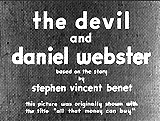


The Devil and Daniel Webster (1941) (aka All That Money Can Buy), 107 minutes, D: William Dieterle
This cautionary moral tale was faithfully based on Stephen Vincent Benét's 1937 Faustian short story, with an Oscar-winning score by Bernard Herrmann. In 1840, poor, 27 year-old Cross Corners, New Hampshire farmer Jabez Stone (James Craig), a kind-hearted man, married for two years to Mary (Anne Shirley), was down on his luck. His family and shrewd and wise mother Ma Stone (Jane Darwell) faced eviction and were in debt to local loan shark Miser Stevens (John Qualen) - threatened with poverty and farm foreclosure. He idly offered to sell his soul for two cents to the jolly but ruthless Mr. Scratch (Walter Huston), aka The Devil or Satan (Mephistopheles). For seven years, Jabez would become financially prosperous and wealthy with lots of good luck (and "all that money can buy"), after which the Devil would take his invisible soul. Jabez found Hessian gold coins under the floor of his barn and immediately paid off his debts to Stevens, and became richer and richer (with the townsfolk owing him money as a fearsome land baron), but also became greedy and hard-hearted. Also, Scratch sent his bewitching and alluring live-in housemaid/nanny/temptress Belle (Simone Simon), callously driving off his wife Mary and newborn son. He also took up drinking and gambling. When 7 years was up, Jabez was given the option of giving up his son to save his soul - but he refused. He enlisted the aid of local hero and famous silver-tongued orator/politician Daniel Webster (Edward Arnold) to defend him - with a jury trial - to plead his case and win back his soul from an iron-clad contract. In the film's dramatic conclusion, the 12-person jury of the "damned" summoned by the Devil was composed of infamous cutthroats, brigands and traitors in American history, such as Benedict Arnold, who had previously sold their souls also. The judge was Justice John Hathorne (W.B. Warner) of the Salem witch trials, who refused cross-examination, and denied disqualification of the prejudiced jury. With eloquent oratory in the final moments, Webster gave an impassioned closing argument, which persuaded the jury and the court to turn against Mr. Scratch, destroy the contract, and have mercy on Jabez's soul.

Dumbo (1941), 63 minutes, D: Disney Studio
Disney's charming, animated story was released to theaters around the time of the surprise attack on Pearl Harbor in Hawaii. It was the first of the Disney animated features to be released on videocassette (in 1981). It was a twist on the classic ugly duckling story, in its story about a shy little circus elephant named Dumbo. The baby pachyderm was criticized, ridiculed, and outcast for his ears which were big enough to fly with. He was separated from his mother, Mrs. Jumbo, when she was branded a mad elephant for defending him. He was befriended by circus mouse Timothy Mouse who built his confidence. Dumbo became the overnight sensation of the circus with his flying act, and he was reunited with his mother.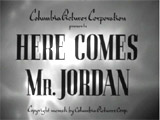


Here Comes Mr. Jordan (1941), 93 minutes, D: Alexander Hall
This highly inventive comedy-fantasy film (with an Oscar-winning Original Screenplay) contained many plot twists and turns, and was similar in plot to Angel on My Shoulder (1946). The 1941 film's sequel was Down to Earth (1947), and it was cleverly remade as the sports fantasy Heaven Can Wait (1978) with Warren Beatty as a football player, not a boxer. It was not to be confused with Heaven Can Wait (1943) starring Don Ameche and Gene Tierney. In the story, good-natured saxophone-playing prizefighter Joe Pendleton (Robert Montgomery), "The Flying Pug," died in a plane crash in New Jersey 50 years too early due to a heavenly screw-up. He was prematurely brought to heaven (he was supposed to survive the crash) by bumbling, inexperienced busybody Heavenly Messenger No. 7013 (Edward Everett Horton) for check-off by Mr. Jordan (Claude Rains). Because heaven had called him too soon, he was sent back to Earth to live out the remaining years allotted to him, occupying someone else's body. Escorted by Mr. Jordan back to Earth, the body he entered was that of unscrupulous multi-millionaire playboy Bruce Farnsworth who had just been murdered by drowning in his bathtub by his scheming and greedy wife Julia Farnsworth (Rita Johnson) and his male secretary Tony Abbott (John Emery). The murderous pair were shocked and confused to see the deceased suddenly re-emerge from the bathroom. He also utterly befuddled his former fight manager Max Corkle (James Gleason), although was able to secretly reveal his soul's identity. Joe's/Farnsworth's reincarnated spirit fell in love with Bette Logan (Evelyn Keyes), the daughter of a man that Farnsworth had framed for securities fraud. Farnsworth trained with Max to enter a heavyweight championship boxing match against the reigning champ, when Joe/Farnsworth was again murdered by his secretary. Joe's/Farnsworth's replacement in the prize-fight with the champ was K.O. Murdoch. As the fight was about to begin, Murdoch, who had run afoul of the mob, was shot in the ring for betraying gamblers (by not "throwing" the fight). Joe's soul quickly took Murdoch's place, and awakened in Murdock's body lying on the floor of the ring. Joe, as Murdoch, defeated his opponent and won the title of world champ, with only Max realizing that Joe's soul was in Murdoch's body. Murdoch lost his memory of his past life as Joe. In the conclusion, he was strangely drawn to Bette, even though they hadn't met.



High Sierra (1941), 100 minutes, D: Raoul Walsh
Raoul Walsh's landmark gangster film from Warner Bros. studios (with a script by John Huston adapted from the book by WR Burnett) was remade as a western titled Colorado Territory (1949) with Joel McCrea, and as I Died a Thousand Times (1955) with Jack Palance. It told about aging notorious gangster Roy "Mad Dog" Earle (Humphrey Bogart in his first lead role, although second-billed behind Ida Lupino). Pardoned after 8 years in prison, he was hired by his old crime boss, Big Mac (MacBride), to help amateur cons plan and carry out the jewel heist of a California resort hotel - one final job. He met a runaway dance-hall girl named Marie (Ida Lupino), the girlfriend of one of the thugs nicknamed Babe (Alan Curtis), who eventually became his 'tarnished angel' friend. Before the robbery, he met a destitute grandfather ("Pa") (Henry Travers) and club-footed Velma (Joan Leslie), and offered to pay for surgery to correct her disability. When he visited her after the successful operation, she rejected his marriage proposal ("We can still be friends..."), and he felt heartbroken and betrayed. Although the heist was successful, everything unraveled after a car crash, a cop was killed, and an inside connection squealed to police. In the conclusion, Earle was the target of a suspenseful manhunt high up in the Sierra Mountains as police pursued him in a doomed last stand. Marie refused to call out to him as she told the authorities: "He's gonna die anyway, I'd rather it was this way. Go on, all of you, kill him, kill him..." Earle was shot dead from behind when he called out to his mongrel dog Pard. After he had been killed out in the open, a weeping Marie knelt over Earle's dead body, and asked an uncaring officer (who sarcastically called the dead man "Big-shot Earle" - "Look at him lying there. He ain't much now, is he?"): "Mister, what does it mean when a man crashes out?" When told that it meant being freed ("It means he's free"), she sadly repeated the word "Free?", questioning Roy's unnecessary death. She picked up Pard as she was escorted away and said the word "Free" one more time. The film ended with a blurry fadeout on Marie's tear-stained face as it filled the frame before a pan up to the mountains.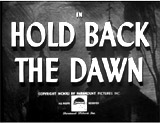


Hold Back the Dawn (1941), 115 minutes, D: Mitchell Leisen
This touching, moving soap-opera style melodrama from Ketti Frings' semi-autobiographical story was the last film written by Billy Wilder with his scripting partner Charles Brackett, before he embarked on his own directorial career. This was also the year that this film's star Olivia de Havilland was nominated as Best Actress, competing against her successful sister Joan Fontaine, also nominated for Suspicion (1941) - the first time for a pair of siblings. The film's plot was told in flashback - in the preface, the main character visited Paramount Studios in Los Angeles to sell his hard-luck romantic story to director Dwight Saxon (Mitchell Leisen, the film's actual director), for $500. An unscrupulous, hopeless Romanian refugee, dancer Georges Iscovescu (Charles Boyer) from oppressive war-ravaged Nazi Germany, was stranded in Tijuana, a Mexican border town in the Hotel Esperanza with a number of other hopeful immigrants to the US, stuck with a waiting period of five years. His plan to satisfy immigration officials, especially Inspector Hammock (Walter Abel), was to marry a US citizen to gain entry (requiring only four weeks for a visa). He met and married a lonely, shy, innocent, and trusting American schoolteacher Emmy Brown (Olivia de Havilland), who was visiting with her students on a school trip. Desperate to escape his situation, Iscovescu, a former gigolo, deceitfully lured the gullible Emmy into a quick matrimonial immigration scheme to merely gain entrance. His plan was to desert her after gaining entry, and link up with his old jealous girlfriend Anita Dixon (Paulette Goddard) from the Cote d'Azur who had also married an American to get into the US (and then had dumped him). But then, they both fell deeply in love with each other, evidenced by Georges crossing the border illegally when Emmy had a car accident and was hospitalized and unconscious in Los Angeles. [This was when Georges requested $500 in the preface, to be used to help Emmy.] Although Georges was arrested and brought back to Mexico, he was soon released to cross the border to be with Emmy.


How Green Was My Valley (1941), 118 minutes, D: John Ford
Director Ford's film was derived from Richard Llewellyn's best-selling autobiographical novel about labor unrest, personal tragedy, the end to a way of life, and the power of the family. It was beautifully directed, vividly photographed, and performed, with a well-written screenplay, and was one of John Ford's masterpieces (for which he won his third Best Director Oscar). It was highly controversial though, because it won the Best Picture Academy Award over two superior classics: Citizen Kane (1941) and The Maltese Falcon (1941). In voice-over, the life of a Welsh coal mining town in the late 1800s and early 1900s was seen through the sensitive eyes of the youngest son Huw (Roddy McDowall) of the hard-working, close-knit Morgan family (with seven children), relating the story in flashback. Many memorable performances included the family's strict anti-union patriarch Gwillym Morgan (Donald Crisp) and matriarch Beth (Sara Allgood), and the noble-spirited beauty - the lovely unmarried 17 year-old daughter Angharad (19 year-old Irish actress Maureen O'Hara). Domestic life, romance, harsh treatment at school, the departure of two Morgan boys to find their fortune in America, unrequited love between the local preacher Mr. Gruffydd (Walter Pidgeon) and the only Morgan daughter, and other events (such as a labor dispute, and a devastating mine accident) were portrayed within the warm, human story.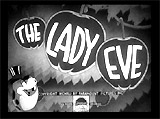


The Lady Eve (1941), 93 minutes, D: Preston Sturges
Director Preston Sturges' classic, witty, romantic screwball comedy of the 1940s featured traditional fast-paced dialogue, farce, slapstick (actor Fonda's multiple pratfalls) and visual humor. Considered possibly as Preston Sturges' best film, it was a wonderful 'battle of the sexes' comedy. Con artist, swindler, and professional card shark Jean Harrington (Barbara Stanwyck), with her crooked father "Colonel" Harry Harrington (Charles Coburn) made their living by charming gullible multimillionaires out of their money. On board a luxury ocean liner, she selected her next victim, millionaire herpetologist/ophiologist Charles "Hoppsy" Pike (Henry Fonda), the socially-awkward heir to a brewery fortune, who had just returned from an expedition up the Amazon River. When he was set up, she ran into one difficulty - she fell in love with her victim, but he found out about her ulterior motives before she could confess, and he dumped her. To get revenge for being coldly dropped, she posed with another identity - as an English aristocratic lady, Lady Eve Sidwich, and he fell in love with her all over again in front of his tycoon father Horace (Eugene Pallette) at the Pikes' Ridgefield, Connecticut mansion. She later extracted her revenge on their honeymoon on a speeding train.

The Little Foxes (1941), 116 minutes, D: William Wyler
Director Wyler's drama was adapted from Lillian Hellman's play (with assistance from others including Dorothy Parker), with fabulous cinematography (deep-focus) by the acclaimed Gregg Toland. It was followed by the pre-quel Another Part of the Forest (1948) with Fredric March and Ann Blyth. This was the third icy, mostly-villainous female role that Bette Davis performed for director William Wyler (after Jezebel (1938) and The Letter (1940)). It was the turn-of-the century story about a greedy, corrupt, and dysfunctional Southern family, the Hubbards, who attempted to build a factory on what was once a beautiful plantation. Brothers Ben (Charles Dingle) and Oscar (Carl Benton Reid) schemed to bring industry by building a cotton mill in their small southern town. But they needed the capital of their sister Regina's (Bette Davis) banker husband Horace Giddens (Herbert Marshall) in order to make the deal. The principled Horace, who was an invalid with a bad heart, wanted no part of their exploitative scheme despite Regina's requests. Regina's nephew Leo Hubbard (Dan Duryea), who worked in the bank, stole some bonds from Horace's safe-deposit box to make the deal work. Learning of the theft, the ruthless, manipulative and conniving Regina blackmailed her brothers into giving her a percentage of the business. Horace, however, foiled Regina's scheme when he informed her that he actually gave the money as an interest-free loan, and that he was changing his will in favor of their daughter Alexandra Giddens (Teresa Wright). Before he executed the change, he suffered a heart seizure and collapsed, and in a very bold and memorable scene, the heartless and avaricious Regina refused his pleas for help to get his medicine as he expired on the staircase. The cold-hearted Regina was left alone and deserted by her daughter.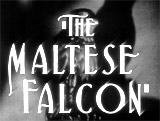






The Maltese Falcon (1941), 100 minutes, D: John Huston
This is one of the greatest and earliest film-noir crime-detective mysteries of all-time. Director and scriptwriter John Huston's film version (his incredible directorial debut!) of author Dashiell Hammett's hard-edged and cynical detective novel was about greed and deceit, and a quest for a deceptive black bird ("The Maltese Falcon"). It was previously filmed, also by Warner Bros., as two lesser films: The Maltese Falcon (1931) (aka Dangerous Female), with Bebe Daniels and Ricardo Cortez, and as director William Dieterle's Satan Met a Lady (1936) with William Warren and Bette Davis. And then it was poorly remade as Roger Corman's Target: Harry (1969), and the comedy The Black Bird (1975) with George Segal. This version boasted superb moody images, a sinister atmosphere, a pace that accelerated as tension mounted, and an innovative film noir style. In the fast-paced B/W story, hard-boiled San Francisco sleuth/private eye Sam Spade (Humphrey Bogart) and his partner Miles Archer (Jerome Cowan) were approached in their 1940s San Francisco office and hired by pretty client "Ruth Wonderly" (Mary Astor) (an alias for her real name Brigid O'Shaughnessy, a treacherous and deceptive femme fatale) to trail her that evening. She falsely claimed to them that a man named Floyd Thursby (entirely off-screen) had run off and eloped with her younger sister and she wanted to locate her. That evening, the dutiful Archer was shot dead at point-blank range, and it was also reported shortly later by the authorities (by plainclothes Police Sergeant Tom Polhaus (Ward Bond)), that Thursby had also been killed - shot in the back. Had Spade retaliated in revenge for his partner's death? [Note: Thursby was actually Brigid's partner that she wanted eliminated.] Spade quickly became a murder suspect due to his ongoing affair with Archer's wife Iva (Gladys George). He found himself at the center of a great deal of attention by a group of shady, unsavory characters, including Brigid, Fat Man Kasper Gutman (Sydney Greenstreet) and his henchmen: effeminate homosexual Joel Cairo (Peter Lorre) and hired baby-faced, dim-witted gunsel Wilmer (Elisha Cook, Jr.). The group of murdering conspirators, an international gang of crooks, were on an elusive search for a valuable "black bird," a stolen jewel-encrusted Maltese Falcon statuette. Although Spade was lied to repeatedly by Brigid, he saw through her phoniness, but ended up drugged and knocked unconscious by Wilmer during his second interview with Gutman in his hotel suite. Afterwards, Spade acquired the statuette delivered to him in a package in his office by a dying Captain Jacobi (Walter Huston, John's father) of "La Paloma" that recently docked from Hong Kong. [Note: Jacobi had presumably been murdered by Wilmer, who had also killed Thursby.] Eventually, Spade brought together the uneasy alliance of self-interested, greedy falcon-seekers in his apartment, where he turned over the statue he had acquired from Jacobi - it turned out to be a fraudulent, lead counterfeit fake. Everyone but Brigid departed (while Spade reported Gutman, Cairo, and Wilmer to the police, as they left to continue their search in Istanbul). In the film's denouement, a dramatic confrontation, Brigid confessed to Spade that she had murdered his partner Miles, using Thursby's stolen gun in order to implicate him. Spade insisted that Brigid must be punished for her crime, for ethical reasons: "When a man's partner's killed, he's supposed to do something about it." He turned her over to the police, while sarcastically promising to be there when she was released, or to think of her if she was hanged. She was taken down in the enclosing cage of an elevator. Spade's parting words to Det. Sgt. Polhaus referred to the black bird: "The stuff that dreams are made of."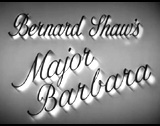


Major Barbara (1941, UK), 131 minutes, D: Gabriel Pascal
Hungarian emigre producer/co-director Gabriel Pascal's social satire and sophisticated comedy about poverty, spirituality and wealth was based on the 1905 stage play of the same name by well-established playwright George Bernard Shaw. An earlier Shaw play adapted for the big screen was Pygmalion (1938, UK). As he had done for Pygmalion, Shaw wrote the screenplay for the film (assisted by Anatole de Grunwald), and although changes were required to transition from the stage play to the film format, it basically retained the themes and structure of the original. The film's length was an issue, and Pascal's full 2 hour and 11 minute version wasn't shown until years later. Problems with filming included budget and time constraints, censorship, and the ever-present threat of attack during the German blitzkrieg. Each of the three main characters embodied a certain ideal or perspective (in simple terms, religion, education, and commerce). The title character was self-righteous socialist 'Major Barbara' - a young, religious and naively-idealistic Barbara Undershaft (Wendy Hiller), who had joined the Salvation Army to save souls. She despised her estranged, more realistic and wealthy capitalist father Andrew Undershaft (Robert Morley), who was a weapons-armament industrialist-manufacturer during the war years. And thirdly, Professor Adolphus "Dolly" Cusins (Rex Harrison) was a young, elite scholar-intellectual and an ancient Greek history and literature specialist. Other members of Barbara's family in London included her aristocratic, high-society controlling mother Lady Britomart (Marie Lohr), her younger sister Sarah (Penelope Dudley-Ward), and her younger brother Stephen (Walter Hudd). Sarah's often-present engaged suitor in the household was Charles Lomas (David Tree). In the first basic half of the film, the charming Professor fell in love with Barbara during the course of her work when he first met her at one of her ministry meetings, and later, he became a Salvationist (mostly due to his love for her) and a member of the Army's band. Many of the saved souls at the Army's shelter admitted they were there for free food and housing. At the shelter, bullying Cockney non-believer Bill Walker (Robert Newton) beat up his teenaged girlfriend Jenny Hill (Deborah Kerr in her film debut), but was subdued and made to change his ways and seek forgiveness by Major Barbara's intervention. In the second half of the film, Andrew Undershaft unexpectedly donated 50,000 pounds to the Salvation Army that was happily accepted by the Army's General (Sybil Thorndike). He also took Barbara on a tour of his weapons-plant, boasting of how his benevolent capitalistic business improved and benefitted the lives of the common folk and all of mankind more than charity and faith. In protest to the tainted money, Barbara resigned. Searching for an heir to his empire, Andrew disowned his son Stephen (since he wasn't a "foundling"), adopted Cusins instead, and placed him in charge to direct his business. In the end, the disillusioned but converted Barbara with shattered beliefs had aligned herself and found an allegiance to her father's perspective and way of thinking.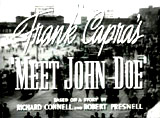

Meet John Doe (1941), 123 minutes, D: Frank Capra
Frank Capra's (and scriptwriter Robert Riskin) dramatic, endearing, and poignant social/political commentary was the director's third Depression-Era populist melodrama - again a parable about an honest, common man's struggle against powerful corruptive forces, following after Mr. Deeds Goes to Town (1936) and Mr. Smith Goes to Washington (1939). Clever young reporter Ann Mitchell (Barbara Stanwyck) for The Bulletin (a NY newspaper in the midst of being sold) was threatened with being fired from her position by her new managing editor Henry Connell (James Gleason) due to her tame and undramatic columns. As a last desperate and manipulative act to keep her job, in her last published column, she created a fictional "John Doe" character to comply with her publisher's demands for content that would stimulate circulation during hard times. In a letter to the editor, her "Doe" individual wrote that he was for the common man and little guy, but was so disgusted by powerful political corruption (and big money interests) that he was going to commit suicide by jumping off City Hall's roof on Christmas Eve. There was a lot of publicity, uproar and ruckus following the letter's publication (in the offices of the Governor (Vaughan Glaser), the Mayor (Gene Lockhart), the Chamber of Commerce and others) - while newspaper circulation dramatically improved. Ann's ploy worked very well as a publicity stunt for the time-being, but after she admitted to Connell that it was a phony letter to simply create "fireworks," she was persuaded to continue writing "John Doe" letters to appeal to the masses. When the public's interest continued to take off, the paper had to save its image and find a bogus impersonator to be the real John Doe. They hired naive, plain-speaking, homeless and unemployed tramp, ex-baseball pitcher "Long John" Willoughby (Gary Cooper) with an injured arm who quickly became a national hero. John (aka John Doe) was joined by his vagrant, disdainful, and anti-social tramp companion who was simply named "The Colonel" (Walter Brennan) - he humorously and skeptically called compromised individuals "heelots." Unwittingly, "John Doe" became the manipulated tool of the paper's unscrupulous, and vicious publisher (of the newly-purchased metropolitan newspaper renamed The New Bulletin) - a corrupt, "fascist" and wealthy right-wing politician named D. B. Norton (Edward Arnold). To keep the scam going, "John Doe" was set up to deliver a 15-minute radio speech (scripted by Ann), to share his idealistic, philosophical, and populist maxims and thoughts about the values of the common person ("the average guys"). His words thoroughly resonated with listeners and followers who began to form "John Doe" Clubs country-wide - a potentially-powerful political force. Although Willoughby was soon disillusioned about being a fake and considered ending the hoax, he was encouraged to prevail by the words of Bert Hansen (Regis Toomey), a self-conscious soda jerk and his embarrassed but proud wife (Ann Doran), who told him how his message of 'love thy neighbor' had changed their lives. Norton was expecting to maximize the popularity of the John Doe Club movement to further his own political ambitions and the establishment of a police state. He had designs to manipulate an upcoming convention as an endorsement for his fascist party's run at the White House. In one of the film's most powerful scenes held at a rally during a rain storm (attended by over 20,000 'John Doe' followers in a ball park), 'John Doe' threatened to reveal the truth. Realizing that the John Doe movement was no longer of any use, Norton publically denounced Willoughby as a fraud. Completely defeated, Willoughby realized that the only way out was to actually commit suicide by jumping off City Hall. All of the main characters were brought together atop City Hall in the final dramatic sequence, to try to dissuade him from suicide. He listened to an hysterical Ann who admitted her love for him and begged and pleaded for him not to kill himself. But it was only after the encouraging words of Bert and other club members ("the people") about their steadfast belief in him, that he decided to not go through with it. The final words of the film were Connell's retort to Norton: "There you are, Norton! The people! Try and lick that!"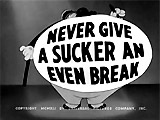

Never Give a Sucker an Even Break (1941), 71 minutes, D: Edward F. Cline
This absurd, wacky film spoofed the film industry and Hollywood, with Fields in his last starring role in a feature-length film. It was a surrealistic film with no real plot, only a series of very funny scenes and bizarre sequences one after the other, to skewer the entire movie business. The Great Man (W. C. Fields), a film scriptwriter, attempted to get backing from a skeptical producer (Franklin Pangborn) at Esoteric Studios for a movie he wished to make about one of his highly improbable romantic adventures. He related the whole story in the hopes of getting financial support. He drunkenly fell out of an airplane, diving to retrieve his bottle of booze, and fell thousands of feet to the ground. He landed in a strange country named Ruritania in the mountain retreat of Mrs. Hemoglobin (Margaret Dumont). There, he met attractive Ouliotta Delight Hemoglobin (Susan Miller), who had never met a man - and he taught her how to play "Post Office." The producer threw the Great Man out of his office after listening to the absurd, impossible tale. The film concluded with a classic car chase scene - he drove an obese woman through downtown Los Angeles to the maternity hospital.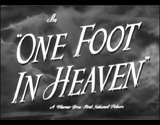

One Foot in Heaven (1941), 106 minutes, D: Irving Rapper
This wholesome, nostalgic, heartwarming, poignant and moving film was told episodically, and based on a biographical book written by Hartzell Spence, the son of the actual real-life minister. Although trained to be a doctor, William Spence (Fredric March) in the early 1900s decided to quit his studies and devote himself to God and ministry. The Rev. Spence, now a devoted Methodist minister began his work in a small town in an Iowa community at the turn of the century. He moved from community to community over a period of years, building up the faith of troubled parishes. With his ever-faithful wife Hope Morris Spence (Martha Scott), they were forced to cope with the clash between fast-changing attitudes and church teachings.

Penny Serenade (1941), 119 minutes, D: George Stevens
Director George Stevens' sentimental marriage (melo)-drama again paired Cary Grant and Irene Dunne for the third time after their popular appearances in The Awful Truth (1937) and My Favorite Wife (1940). A preface or connecting element to each of the flashbacked episodic vignettes was the playing of a popular song on a Victrola phonograph to set the tone and bring back memories. Through flashbacks, the maudlin film followed the romantic courtship and married life of a couple ("The Story of a Happy Marriage") - charming newspaperman and bachelor spendthrift Roger Adams (Best Actor-nominated Cary Grant) and his future wife Julie Gardiner (Irene Dunne). ("You Were Meant For Me") In the film's opening, Julie was working in a NYC record shop where she and Roger first met before dating. By New Years Day, Roger had impulsively proposed marriage to Julie after receiving an offer to work for two years in Japan. Following a hasty marriage and a quick goodbye scene at the train station, Julie couldn't leave him and remained in his train compartment (for a 45 minute honeymoon) until it was over 100 miles on its journey toward San Francisco. ("Poor Butterfly") Three months later, a pregnant Julie joined Roger in Japan, where they rented a large house, and had hired a couple (with three children) to work and live there. After a very brief time in Tokyo, Roger announced that they would be leaving Japan. He had received an inheritance of $10,000, and had decided to quit his newspaper job and travel around the world with Julie. Their plans did not work out, however - in 1923, a major earthquake damaged their house and severely injured Julie, who suffered a miscarriage, became barren, and was hospitalized in San Francisco. Julie recovered and Roger struck out on his own by purchasing a small newspaper in the small town (fictional) of Rosalia, CA, north of SF - The Rosalia Weekly Courier Press. They would both live in a two-story apartment (with living quarters upstairs - with a nursery - and an office downstairs); Roger also hired an old Brooklyn colleague named Apple Jack (Edgar Buchanan) as his printer and press manager. After a few years, the despondent, childless parents decided to adopt a child, and visited an adoption agency in San Francisco to meet with kindly case worker representative Miss Oliver (Beulah Bondi). They were told that the long waiting list meant they might not have an adoptee for a year. Roger exaggerated when asked during an investigation about his finances, and bragged that he made $100 dollars a week. After a waiting period, they brought home a five-week old adopted baby girl named Trina (Baby Biffie) for a year's probation, although at first Roger had stated that he preferred a two-year old boy with blue eyes, dimples and curly hair. However, he immediately fell in love with the baby. Adjusting to parenting for their first few nights was difficult - the flustered couple was exhausted after getting up all night to attend to the baby - they were nervous about keeping quiet, and also were uncertain about how to bathe and diaper the child until Apple Jack demonstrated for them. ("My Blue Heaven") - a year later after the probation period ended, the matronly Miss Oliver arrived to see if the adoption could be permanently approved. Roger was forced to confess that he actually had no income when he was forced to close down the paper. In a scene before a judge (Wallis Clark), during an impassioned speech - the film's highlight, Roger movingly begged and pleaded for the official to grant them a continuation of the adoption, rather than cruelly return the child to the orphanage. Through his words, he was able to convince the judge to let them retain the custody of the child. ("Silent Night") - six years later during Christmas, the two parents were faced some time after with the sudden and unexpected death of their six-year-old child Trina (Eva Lee Kuney) following a brief illness. As a result, the couple had become downtrodden and estranged to each other - and Roger wanted no reminders of his dead child and felt they should dissolve their marriage. The bereaving Mrs. Adams wrote a letter to the saddened Miss Oliver notifying her: ("Since the night of Trina's death, we have been like strangers to one another. I don't know what to do. It seems as if there is nothing between us any more. I've tried to talk to him, but he does not wish to listen. He is punishing himself, not realizing that he is also punishing me"). ("You Were Meant For Me") - now in the present, the two guilt-ridden parents Roger and Julie were still essentially separated, and felt defeated in life. Unexpectedly, they received a phone call from Miss Oliver that another child - a two-year old boy, was being offered for adoption to them: ("He's the exact image of the youngster you asked for when you first wrote to me. Do you remember? I have that old letter here in front of me now - 'Curly hair, blue eyes, dimples'. And this is strictly off the record, but really, another couple has the right to see him first, but he's such a remarkable baby that I thought perhaps you and Mr. Adams might take a look"). The film ended on a hopeful and optimistic note - Julie responded with great anticipation that they wanted to adopt - and in the process restore their marriage: "Please don't have that other couple see him until we do!"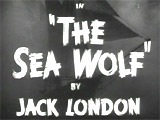

The Sea Wolf (1941), 100 minutes, D: Michael Curtiz
Director Michael Curtiz's brisk, film-noirish sea adventure drama was based upon author Jack London's 1904 classic literary novel (a "GREAT NOVEL OF TERROR AFLOAT") - it was the fifth (and most memorable) film version after other versions in 1913, 1920, 1926, and 1930. Later, there were also two other related films: Wolf Larsen (1958) starring Barry Sullivan, and The Sea Wolf (1997) starring Stacy Keach. It featured a superb musical score by Erich Wolfgang Korngold. Screenwriter Robert Rossen's script provided an analogy between the film's allegorical title character and the war-time Fascist powers (Nazi's Hitler) that had adopted philosopher Friedrich Nietzsche's theories regarding a 'superman' and a "Master Race." In the opening of the film's rousing tale in the year 1900, a ferry collided with another vessel and sank, causing many of the passengers to drown. Two of the survivors in the water: effete intellectual and altruistic, idealistic fiction writer Humphrey Van Weyden (Alexander Knox) and an escapee from the Lyndale Reformatory for Women - the smart and good-looking Ruth Webster (Ida Lupino), were brought on board a seal-hunting freighter known as the Ghost before departing from San Francisco Bay. The sailing ship was helmed by malevolent, immoral, cold and evil "Wolf" Larsen (Edward G. Robinson) - a sadistic, abusive, domineering and crazed psychopath. The amoral Captain's Satanic credo for life was taken from John Milton's Paradise Lost: "Better to reign in Hell than serve in Heaven." Some of his callous, misfit, outcast and coarse crew members of the hellish pirate ship, shanghai'ed from the Barbary Coast, included: George Leach (John Garfield) - another fugitive from the law who had volunteered to work on the ship, a drunken and pathetic Doctor Louis Prescott (Gene Lockhart) and a cook nicknamed Cookie (Barry Fitzgerald). The two passengers (and crew) were held captive and suffered cruel and brutal treatment by Wolf. During the voyage, without his permission, Leach was volunteered to provide a blood transfusion for the ailing Ruth, to save her life. Before committing suicide by jumping from the mast, the desperate and ridiculed Dr. Prescott revealed the true mission of Larsen's vessel - it wasn't a seal-hunting vessel after all, but was sailing to avoid Larsen's vengeful sea-captain brother, known as "Death" Larsen, who was hunting him down. An attempted mutiny to escape from the ship was led by the rebellious Leach, but the plan failed when deterred by Wolf who quickly reclaimed authority. It was revealed that the tyrannical Captain often suffered from severe and debilitating headaches that caused seizures. He was keeping his ailment a secret from the crew that his headaches caused temporarily blindness. The Captain's brother "Death" Larsen caught up to the Ghost and attacked and damaged it. Van Weyden, Webster, and Leach had the opportunity to escape in a lightweight boat, but discovered that their water supply had been tainted with vinegar. Adrift in the fog, they believed that a ship had arrived to rescue them, but it was only the Ghost - now mostly destroyed by Larsen's enemy-brother. With no other option after being drawn back to the Ghost, the three reboarded the slowly-sinking vessel and found the nearly-insane Captain alone and blind. Larsen locked Leach in the supply storeroom, and then after a long discussion with Van Weyden about his predicted, upcoming "mean, petty, and cheap" death, he shot and mortally-wounded Van Weyden. To trick and outwit the blinded Larsen, Van Weyden pretended that Larsen's shot had missed. He self-sacrificially bargained to exchange his life for Leach's and agreed to remain in Larsen's company as the ship went down. Larsen agreed to release Leach from the storeroom, and he and Ruth were freed to escape together and row to a nearby deserted island. Meanwhile, Van Weyden - who had known that he would soon succumb to his lethal wounds, crumpled over dead. Larsen knew that he had been tricked, but gloated that he had successfully shot Van Weyden. He stood defiantly as the waves crashed in and enveloped him and his ship, and took him to his death.


Sergeant York (1941), 134 minutes, D: Howard Hawks
Director Howard Hawks' true, inspirational, but unusual biographical (biopic) story of the Great War's biggest war hero (Alvin York) was the highest grossing film of the year. It was a sensitive, affecting, and compassionate portrayal of York with fast-paced action sequences and some wartime propagandizing (as the US was becoming more involved in WWII). The war film was heightened by Max Steiner's effective musical score. The authentic war saga offered a portrait of poor, hell-raising mountain boy and sharp-shooting farmer Alvin C. York (Best Actor-winning Gary Cooper) living in the backwoods Tennessee Valley of the Three Forks of the Wolf before the US' entrance into the Great War in Europe in 1916. His hot-headed brawling and drunken life in Pall Mall changed when he fell in love with local, teenaged Gracie Williams (Joan Leslie). Although attracted to Alvin, when he asked for her hand in marriage, she rejected him: ("I wouldn't have you on a Christmas tree, Alvin York! Hmm, fine husband you'd make!...Folks say you're no good except for fightin' and hell raisin' and I'm thinkin' they're plumb right"). To impress her, and to steal her away from a rival suitor, Zeb Andrews (Robert Porterfield), the determined Alvin worked hard to buy some farming bottomland for them sometime in the future, as he promised: ("There ain't nothin' I can't get if I set my mind to it"). Later, when he sought revenge for being cheated out of some bottomland, an angered and bitter Alvin had a life-changing religious experience signaled by a bolt of lightning during a thunderstorm. As he was riding along on muleback, a flash of lightning struck closeby, and he awoke on the ground after being thrown off. He noticed that his mangled rifle (with a split barrel) had served as a lightning rod and had saved his life. The Great War progressed and by mid-1917, Alvin refused to register for the draft after he had become deeply religious and pacifistic. He vowed to Pastor Rosier Pile (Walter Brennan): ("I ain't a-goin' to war. War is killin', and the book's agin' killin! So war is agin' the book!"); his request to register as a conscientious objector (CO) was denied, and he was reluctantly drafted into military service after all appeals failed. After a tearful goodbye to Gracie, York was trained at Camp Gordon in Georgia, and impressed his superiors with his great marksmanship by hitting five consecutive bulls-eyes. In a crossroads about the direction of his life, he returned home for a brief leave of absence, where on a rock ledge, he read the Biblical passage in Matthew: "Render unto Caesar the things that are Caesar's, and unto God the things that are God's." He decided to accept a promotion to the status of Corporal, and was shipped out to Europe to the war front. York heroically fought in the Great War during many fast-paced action scenes, including tracking shots of York's scramble through no-man's land. Most famously in the Battle of the Argonne Forest in 1918, Sgt. York (almost single-handedly) killed about 25 Germans (some were in a machine gun nest) to save his comrades - by using the tactic of sneaking up on them from behind and picking them off from the rear first: "Just like a flock of turkeys." He also forced a white-flag truce and captured a large regiment of 132 German soldiers, but he also became very disheartened by the ambush-killing of his best friend "Pusher" Ross (George Tobias), a Bronx NY subway guard, who died from a grenade blast at close range thrown by one of the captured Germans. York became the most decorated soldier of the war both in France and US, and was lauded by Gen. John J. Pershing, the leader of the AEF (American Expeditionary Forces), and received numerous medals of honor. Upon his return to the US, he was greeted with a ticker-tape parade in NYC, the key to the city, and numerous temptations of wealth and fame, and was assailed with offers by merchandizers to promote their products and make public appearances, but he refused to profit from serving his patriotric duty. He soon chose to return to his Tennessee roots, where he received a major homecoming welcome, and to his surprise, he was gifted farmland and a house on 200 acres of prime bottomland by the people of his home state. Now, there would be "no need to wait" to get married, according to Gracie: ("It's yours, Alvin. It's all yours. They give it to you. The people of the state of Tennessee for what you done....And it's for us"). Alvin responded with complete disbelief: "The Lord sure does move in mysterious ways."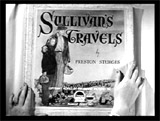


Sullivan's Travels (1941), 91 minutes, D: Preston Sturges
Director Sturges' landmark, classic Hollywood satire and social comedy was thought by many to be his greatest film. A successful yet naive Hollywood film director John L. Sullivan (Joel McCrea), known for making lightweight, trite movies (musicals and comedies), became disgruntled. He decided to research his next "message" picture to be titled "O Brother, Where Art Thou?" - one that would be more socially worthwhile and meaningful, by leaving Hollywood disguised in hobo's clothing with only ten cents in his pocket. He nomadically set off cross country for new material for his next movie - about how the common people were experiencing the Great Depression, so that he had a fresh, first-hand experience of the dark days of suffering. He was joined by a job-seeking, would-be, disenchanted and nameless starlet dubbed The Girl (Veronica Lake) to encounter the common people during a tour and journey across America. Only when Sullivan, after failed attempts to shake off the publicity-seeking studio, experienced real poverty, loss of his name and memory, and his freedom, did he begin to understand the plight of his beaten companions. After he viewed a Disney cartoon (Playful Pluto) in a brutal work camp where he had been sentenced to a 6-year term for an assault of a rail-yard boss, he discovered the real value of laughter. In the film's plot twist, to escape from the prison farm, Sullivan made a false confession to his own murder in order to be recognized in pictures printed in newspapers - the ploy worked; his studio and friends realized he was still alive, and he was safely returned to Hollywood. There, he was reinvigorated to continue making comedies that would lift people's spirits.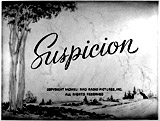


Suspicion (1941), 99 minutes, D: Alfred Hitchcock
British director Alfred Hitchcock's release of this romantic and suspenseful classic thriller was based upon the 1932 novel 'Before the Fact' by Francis Iles. The film ended up being puzzling, after Hitchcock was forced to alter the film's ending following preview showings. He had to change the film's basic themes and plot points that the husband was guilty of murdering his own wife - the heroine. The revised film made a significant switch - it only appeared that the husband was guilty, due to circumstances, and the wife survived. After its release, Joan Fontaine won the Best Actress Academy Award - it was the sole Oscar win for an actor in a Hitchcock film. [Note: Some thought it was a consolation prize for Fontaine's loss the previous year for Rebecca (1940). In 1941, Fontaine was in Academy Award competition with her own sister Olivia de Havilland, nominated for Hold Back the Dawn (1941).] The loving but shy, inexperienced, matronly and repressed English heroine Lina McLaidlaw (Joan Fontaine) was introduced as the prim, over-protected, sheltered, spinsterish daughter of stuffy, wealthy, retired General McLaidlaw (Cedric Hardwicke) and his respectable wife Mrs. McLaidlaw (Dame May Whitty). Once the bespectacled wallflower Lina met handsome, suave, charming, playboyish Johnnie Aysgarth (Cary Grant), he romanced her, and lovingly called her "monkeyface." She hopelessly fell in love with him, although her parents disapproved of Aysgarth as a scoundrel and opportunist with a womanizing, fortune-hunting reputation. Blindly in love, and after an unusual courtship, she assented to a request to be married, even though Lina knew very little about him and his background. After eloping and a whirlwind honeymoon and romance, Johnny began to reveal his true self - he was shown to be an irresponsible cad, a dishonest liar, and a thief. In addition, he was financially-broke (with no employment or income). Johnnie was pressured to take a job after he learned that Lina's monthly-income couldn't support the two of them. He took a position with a distant, obscure cousin Captain Melbeck (Leo G. Carroll), as an agent to help manage estates. It was soon revealed that Johnnie had gambled on horse-racing with the money he earned, and then pawned off two McLaidlaw family heirlooms (antique chairs) to pay off his racing-gambling debts. Lina began to unearth clues and discovered that Johnnie had criminally-embezzled 2,000 pounds from his employer and was discharged from the job, but never told her. She began to seriously consider leaving Johnnie and breaking up their marriage. Lina's fears intensified when notified by telegram that her father had died, and Johnnie was very disappointed that Lina had not inherited his fortune. One evening, the increasingly-suspicious and untrusting Lina was playing anagrams with Johnnie and his jovial, naive, past school friend and drinking buddy "Beaky" Thwaite (Nigel Bruce). Beaky was also Johnnie's prospective business partner for a highly-speculative land development scheme. During the game, the word "MURDER" was formed and Lina fell faint to the floor. She fearfully concluded that Johnnie might be conspiring to murder his friend, as another means to restore his finances. She had a visionary premonition that Johnnie pushed his friend from a cliffside (a prophetic and haunting image that would resurface). During conversation over dinner, juxtaposed with the slicing and cutting of Cornish game hens, the subject of talk was murder. Lina also remained tense due to learning about Johnnie's obsession with reading murder mystery novels, and talking about the use of untraceable poisons, including using brandy as a murder weapon. Soon after, Beaky was found dead in Paris under mysterious circumstances (he was allergic to brandy) - and Johnnie was considered the prime suspect for murdering him, due to his lying to authorities about his whereabouts. Lina was driven to psychosomatic illness and became bed-ridden due to her distrust and fear of her husband. She fearfully learned, with mounting tension as the film progressed, that he could benefit from her death via collecting on a payoff from her life insurance policy. The shadows from the skylight in the front hall cast a giant spider-web appearing to trap Lina. In the film's most famous and suspenseful sequence, at bedtime, Johnnie carried a glowing glass of milk (that may or may not have been fatefully poisoned) upstairs to his sick wife Lina while taking care of her - she stared at the glass with dread (and left it untouched) - believing that she was about to be poisoned. Was Johnnie truly devious and villainous, or was it solely a conspiratorial thought in her fragile mind? In the film's climactic conclusion, Johnnie insisted on driving Lina to her mother's place. He drove recklessly on the treacherous, twisty cliffside drive, when Lina's passenger door unexpectedly opened up and there was a struggle as he lunged toward her with unclear intentions - was he about to push her from the vehicle, or to grab onto her and save her? Ultimately, Johnnie stopped the car and helped rescue Lina. She barely escaped death. in the film's denouement (a studio-modified ending, making it a disappointing and contrived finale with a happy ending), Johnny confessed to Lina that he had chosen to end his life - he had become interested in poisons because he was imminently planning to commit suicide (with an untraceable poison), to escape life's insurmountable responsibilities and the challenges he faced (charges of embezzlement and murder). He was also resolved to spend his life in prison. He told her that when Beaky died, he was in Liverpool, trying to borrow money from Lina's life insurance policy to repay his ex-employer Melbeck. Lina apologized for her constant suspicions and doubts, and the couple resolved to stay together, help each other, and reconcile. However, could all of Johnnie's assertions be trusted and believed, given his past record of falsifying the truth?



That Hamilton Woman (1941, UK), 128 minutes, D: Alexander Korda
Director Korda's touching, poignant and sadly beautiful costume drama was reportedly Winston Churchill's favorite film. It was a realistic, historical portrayal of the ill-fated, tragic romance between England's famous Naval Commander/hero Lord Admiral Horatio Nelson (Laurence Olivier) and Lady Emma Hart Hamilton (Vivien Leigh), portrayed by two married stars who also had an affair while married to other spouses. The story was told in flashback by a drunken cellmate, the former Lady Hamilton. She was a beautiful, vivacious and intelligent woman of poor, common origin - a dance hall girl. She had raised herself up to become an unloved "trophy" wife of the British ambassador to the court of Naples, Sir William Hamilton (Alan Mowbray) in 1786. Seven to eight years later, Lady Hamilton met the dashing Nelson when he again visited Naples to ask for the king's support in the fight against Napoleon - and soon Nelson was victorious in the British war in Egypt against the French. When he returned as a wounded Admiral, they fell passionately in love - and she took care of him when he was exhausted and in poor health (he lost an arm and eye in battle). Sir Hamilton allowed their affair occur. But their love was continually thwarted because Lord Nelson was married to a stern and unforgiving Lady Nelson (Gladys Cooper). When Sir Hamilton died, he left his inheritance to his nephew, leaving Lady Hamilton penniless. Lord Nelson asked his wife Lady Nelson for a divorce so that he could marry the pregnant Emma, but she refused. The couple were able to defy gossipers by setting up housekeeping (with their child) for a few years in the English countryside cottage. Emma encouraged Nelson to resume military command against Napoleon's fleet, and although the British forces were victorious at the Battle of Trafalgar in 1805, he was mortally wounded when fatally shot on board his flagship HMS Victory. As a result, Emma was again left destitute.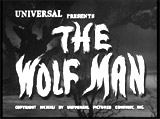


The Wolf Man (1941), 71 minutes, D: George Waggner
One of the last of Universal's great monster films was this classic horror film - a tense, well-made, and eerie production. This film spawned many sequels with Lon Chaney, Jr. continuing in the role with which he would always be identified - the wolfman. Star Lon Chaney, Jr. would eventually star in a total of five werewolf films from 1941 to 1948. It was also remade as The Wolfman (2010) starring Benicio del Toro. Easy-going, innocent British heir Lawrence Talbot (Lon Chaney, Jr.) returned to Wales after 18 years absence to the castle-mansion of his father Sir John Talbot (Claude Rains) after an education in America. When he visited an antiques shop and fell in love with its pretty shopkeeper Gwen Conliffe (Evelyn Ankers), the daughter of the shopowner, he purchased a rare silver-topped, wolf-headed cane with a pentagram design - a symbol of the werewolf. Shortly after, at a gypsy festival attended by Larry, Gwen, and Gwen's girlfriend - beautiful young Jenny Williams (Fay Helm), Jenny had her palm read by traveling gypsy fortune-teller Bela (Bela Lugosi). Nearby was his mother Maleva (Maria Ouspenskaya), another gypsy sorceress - and the results were alarming (the image of a pentagram) - meaning she would be the werewolf's next victim. Then, Talbot was bitten in the chest by a ravenous, hairy werewolf (also Bela Lugosi) when he attempted to save Jenny from being attacked on the foggy moors. When the police investigated, they only discovered the bodies of Jenny and Bela (who had been beaten to death by the silver-topped cane that Larry used as a weapon) - there was no werewolf corpse. Much later during a second visit to the encampment dwelling of Bela's gypsy mother Maleva informed Larry that the bite was from no ordinary wolf - he had been bitten by a werewolf, and at each new full moon, he was now condemned like her son was. Larry was in disbelief and became incensed: "You're insane! I tell you, I killed a wolf! A PLAIN, ORDINARY WOLF!" A few moments later as he was walking out of the festival, Larry confessed to Gwen (who was alone after a quarrel with her fiancee Frank Andrews (Patric Knowles)) what the old gypsy woman had told him: "She said that I was a werewolf." As a result of being bitten by Bela, during an amazingly-effective transformation scene in Talbot Castle (when the moon was full) (filmed with a series of lap dissolves), Larry was transformed into a blood-thirsty, furry bipedal creature, whose first victim was a local villager - gravedigger Richardson (Tom Stevenson). The next morning (Sunday), Talbot transformed back into human form, suffering from amnesia without any recollection of the previous night, although he noted wolf tracks into his castle bedroom. During Larry's second transformation into werewolf form, he became caught and ensnared in one of the wolf-traps set by a hunting party. He was saved when Maleva's magical sorceress spell or chant brought him back to human form. Feeling doomed as a werewolf, Larry decided to leave town permanently. He awakened Gwen in her upstairs bedroom at the shop, and told her he had to leave. He became even more fearful and fled when he saw the fabled pentagram in the palm of her hand - a sign that she would definitely be his next victim. In the final moments of the film, an atmospheric, exciting climax in fog-shrouded woods/swamp (during the full moon), Talbot's father Sir John (with the cane) joined a search party. Gwen ignored warnings given to her by Maleva, and went deep into the woods to find Larry, where the werewolf stalked after her and attacked; Sir John heard her screams and came to her rescue; the beast was bludgeoned to death with Larry's silver-tipped cane, ending the man's suffering. Maleva repeated her incantation to revert the werewolf's body back to human form: ("The way you walk is thorny...Your suffering is over. Now you will find peace for eternity"). Larry was praised by Chief Constable Montford (Ralph Bellamy) as Gwen's heroic rescuer: "The wolf must have attacked her and Larry came to the rescue. I'm sorry, Sir John." In the depressing conclusion, Sir John looked on in horror, realizing that he had slain his own son; Gwen cried out "Larry!" as she collapsed into the arms of her fiancee Frank.